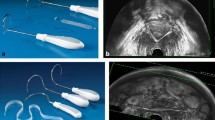Abstract
Introduction and hypothesis
The aim of this study was to determine associations between the ultrasonic appearance of Monarc suburethral slings and postoperative bladder symptoms at an average follow-up time of 11 months.
Methods
A prospective clinical audit was conducted on 98 patients after Monarc suburethral sling. The assessment included pelvic floor ultrasound to determine the gap between the sling and symphysis pubis, the angle formed by cranial and caudal ends of the sling at rest and on Valsalva, and the location of the sling relative to the urethra.
Results
Patients who reported postoperative stress incontinence (SI) or urge incontinence (UI) had a significantly wider gap between the symphysis pubis and sling (P = 0.032 and P = 0.006, respectively).
Conclusions
A narrower gap between the tape and symphysis pubis is associated with both SI and UI cure. Tighter transobturator sling placement seems to be advantageous for the cure of both SI and UI.

Similar content being viewed by others
References
Delorme E, Droupy S, de Tayrac R, Delmas V (2004) Transobturator tape (Uratape): a new minimally invasive procedure to treat female urinary incontinence. Eur Urol 45:203–207
Barry C, Lim YN, Muller R, Hitchins S, Corstiaans A, Foote A et al (2008) A multi-centre, randomised clinical control trial comparing the retropubic (RP) approach versus the transobturator approach (TO) for tension-free, suburethral sling treatment of urodynamic stress incontinence: the TORP study. Int Urogynecol J 19:171–178
Dietz HP, Mouritsen L, Ellis G, Wilson PD (2004) How important is TVT location? Acta Obstet Gynecol Scand 83:904–908
Dietz HP, Mouritsen L, Ellis G, Wilson PD (2003) Does the tension-free vaginal tape stay where you put it? Am J Obstet Gynecol 188:950–953
Dietz HP, Wilson PD (2004) The ‘iris effect’: how two-dimensional and three-dimensional ultrasound can help us understand anti-incontinence procedures. Ultrasound Obstet Gynecol 23:267–271
Haylen BT, Ashby D, Sutherst JR, Frazer MI, West CR (1989) Maximum and average urine flow rates in normal male and female populations—the Liverpool Nomograms. Br J Urol 64:30–38
Dietz HP (2004) Ultrasound imaging of the pelvic floor. Part II: three-dimensional or volume imaging. Ultrasound Obstet Gynecol 23:615–625
Dietz HP, Barry C, Lim Y, Rane A (2006) TVT vs Monarc: a comparative study. Int Urogynecol J 17:566–569
Davila GW, Johnson JD, Serels S (2006) Multicenter experience with the Monarc transobturator sling system to treat stress urinary incontinence. Int Urogynecol J 17:460–465
Houwert RM, Renes-Zijl C, Vos MC, Vervest HAM (2009) TVT-O versus Monarc after a 2–4-year follow-up: a prospective comparative study. Int Urogynecol J 20:1327–1333
Jurgens J, Steller J (2005) Theoretisch-mathematische Modelle zur Kräftewirkung bei alloplastischen Bandsystemen in der Inkontinenztherapie. Gynäkol Geburtshilfliche Rundsch 45:257–261
Bombieri L, Freeman RM, Perkins EP, Williams MP, Shaw SR (2002) Why do women have voiding dysfunction and de novo detrusor instability after colposuspension? Br J Obstet Gynecol 109:402–412
Sander P, Sørensen F, Lose G (2007) Does the tension-free vaginal tape procedure (TVT) affect the voiding function over time? Pressure-flow studies 1 year and 31/2 years after TVT. Neurourol Urodyn 26:995–997
Barry C, Naidu A, Lim Y, Corstiaans A, Muller R, Rane A (2005) Does the Monarc transobturator suburethral sling cause post-operative voiding dysfunction? A prospective study. Int Urogynecol J 17:30–34
Botros SM, Miller JJR, Goldberg RP, Gandhi S, Akl M, Beaumont JL et al (2007) Detrusor overactivity and urge urinary incontinence following trans obturator versus midurethral slings. Neurourol Urodyn 26:42–45
Long CY, Hsu CS, Lo TS, Liu CM, Chen YH, Tsai EM (2008) Ultrasonographic assessment of tape location following tension-free vaginal tape and transobturator tape procedure. Acta Obstet Gynecol Scand 87:116–121
Kociszewski J, Rautenberg O, Perucchini D, Eberhard J, Geissbuhler V, Hilgers R et al (2008) Tape functionality: sonographic tape characteristics and outcome after TVT incontinence surgery. Neurourol Urodyn 27:485–490
Kociszewski J, Rautenberg O, Kolben S, Eberhard J, Hilgers R, Viereck V (2010) Tape functionality: position, change in shape, and outcome after TVT procedure—mid-term results. Int Urogynecol J. doi:10.1007/s00192-010-1119-z
Conflicts of interest
HP Dietz has acted as a consultant for AMS and CCS and has accepted speaker’s fees from GE, AMS, and Astellas. He has also benefited from equipment loans provided by GE, Bruel and Kjaer, and Toshiba.
V Chantarasorn and KL Shek have none to disclose.
Author information
Authors and Affiliations
Corresponding author
Rights and permissions
About this article
Cite this article
Chantarasorn, V., Shek, K.L. & Dietz, H.P. Sonographic appearance of transobturator slings: implications for function and dysfunction. Int Urogynecol J 22, 493–498 (2011). https://doi.org/10.1007/s00192-010-1306-y
Received:
Accepted:
Published:
Issue Date:
DOI: https://doi.org/10.1007/s00192-010-1306-y




